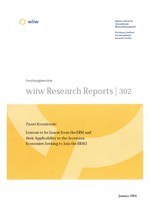Lessons to be Learnt from the ERM and their Applicability to the Accession Economies Seeking to Join ERM2
Pawel Kowalewski
wiiw Research Report No. 302, January 2004
36 pages including 6 Tables and 7 Figures
Sooner or later all the accession economies will have to join the ERM2 - a mandatory framework for all those countries that face the challenge of joining the EU. Entering the eurozone will be an unprecedented achievement. The achievement will be all the more remarkable given the unique environment in which those economies previously operated, so very different to the conditions prevailing among the current EMU members. That notwithstanding, a case can be made for trying to find certain similarities between the ERM and ERM2. As for the ERM, the degree of heterogeneity among its members was sufficient to be able to distinguish between different groups of countries. Of those groups, one bore certain similarities to the accession economies; it mainly comprised the so-called Mediterranean countries (Spain, Italy, Portugal and Greece), all of which faced some of the problems that should sound familiar to at least some of the accession economies.
The Mediterranean countries' bid to join the eurozone and the current efforts on the part of the accession economies are but a decade apart. In the history of the international monetary system, however, a decade is a very long time. Drawing similarities calls for a high degree of prudence. Yet seen from the standpoint of pre-emptive devaluation, it makes sense to take a closer look at the lessons to be learnt from the experience of the Mediterranean countries.
Keywords: ERM, exchange rate, central parity
JEL classification: F31, E5, F15
Countries covered: Greece, New EU Member States, Portugal, Spain
Research Areas: Macroeconomic Analysis and Policy
